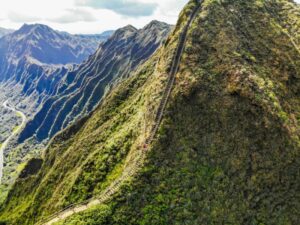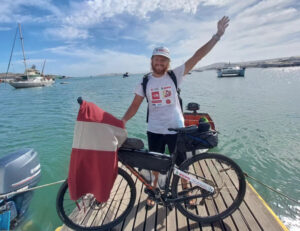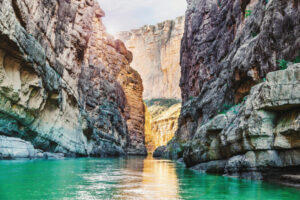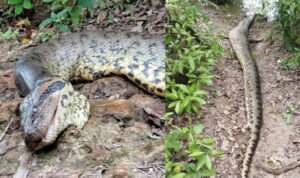Pete Casey set out to walk the Amazon on December 4, 2015, he estimated it would take him two years. Six years later, Casey is still bushwhacking his way along the mighty river.
Casey is traveling only by human power. He has inched his way across the Amazon, slowed by bureaucracy, trouble finding guides, and COVID. After three years in the Brazilian Amazon, he crossed into Peru in late 2018. In theory, this marked the home straight of his journey. Instead, he has spent long periods in lockdown.
Lockdown in rural Peru
When COVID restrictions arrived in Peru, Casey found himself stranded in a remote farmhouse on the Rio Tapiche.
“Despite being on my own most of the time and not having a TV, internet, phone, or radio, I guess I was fortunate to have landed in that place when the world went into lockdown,” he said recently. “Unlike many people around the world, I was always free to leave the house and go into the forest or work in the fields.”

Pete Casey wades the Ene River. Photo: Pete Casey
When he was finally able to leave the Rio Tapiche, Casey, together with an indigenous guide, made a precarious traverse across the Cordillera Azul mountains to the town of Contamana. “Despite the difficulty, due to the pack weight and complex logistics, this traverse was one of the most memorable and interesting to date,” Casey said. “I had felt somewhat trapped at the farmhouse, not knowing when lockdown would lift, and after an exhausting leg-heart-and-lung-busting traverse over the mountains, it was such a relief to arrive in a pleasant town. The food, internet, bed, shops, and mobile signal were very welcoming after seven months in lockdown.”
Guide problems
Aside from lockdowns, Casey has often struggled to find guides. His first guide in Peru disappeared immediately with his pay. Other hires were more successful. Casey speaks highly of Gadiel Sanchez Revira, who guided Ed Stafford during his Amazonian odyssey, and Cho, “the best guide overall for professionalism, trustworthiness, knowledge, and friendliness.”
But even with the best guides, there were often unexpected delays. Casey had to wait for several weeks for Revira to finish a contract and then several more after the birth of Revira’s son. Cho contracted malaria and couldn’t continue, and another guide, Jorge, had to leave after a death in the family.

Casey’s route. Photo: Pete Casey/Ascent of the Amazon
“There is no doubt that the biggest expense of the expedition in terms of both time and money has been arranging guides or walking companions,” Casey said. However, he remains pragmatic: “Despite all the long delays and unforeseen problems, overall, I would say I have benefited in many ways from the participation of all the guides. From the shared experiences, the security, companionship, the negotiating, and the bridge-building between me and the communities I entered.”
The final stretch
Assuming no more major problems arise, Casey’s next big landmark will be Cusco. From there, he plans to walk to one of the Amazon’s sources, a glacial stream that emerges from Mismi, a mountain in the Peruvian Andes. Finally, he’ll climb back down to the Pacific.
This last stretch could involve another 2,000km of hiking. With the journey already stretching three times longer than he planned, how has the expedition has impacted his life?
“I try not to think too much about this,” Casey says. “If I do, I start worrying about everything I’ve sacrificed to do this, including my very hard-earned home, work, and contacts. On the positive side, I’ve learned a lot. My mental horizons have expanded. I’ve learned new languages and learned so much about my environment. I’ve become much more aware of the fragility of our planet.”

Logging is still a major problem in the Amazon. Trees ready for transport at Puerto Prado, on the banks of the Tambo River. Photo: Pete Casey
Climbing into the Andes, Casey will face some mean ascents, as well as serious altitude for the first time. “I’ve never been at altitude apart from flying in a jet!” Casey said. “I hope a slow ascent will help. I’m also considering chewing coca leaves like the locals to help with this. The first part is looking dangerous and difficult as some climbs are very steep, with no trails. My pack weighs a ton. I’m sure I will struggle the first few weeks.”
No stranger to the struggle, Casey will soldier on.






